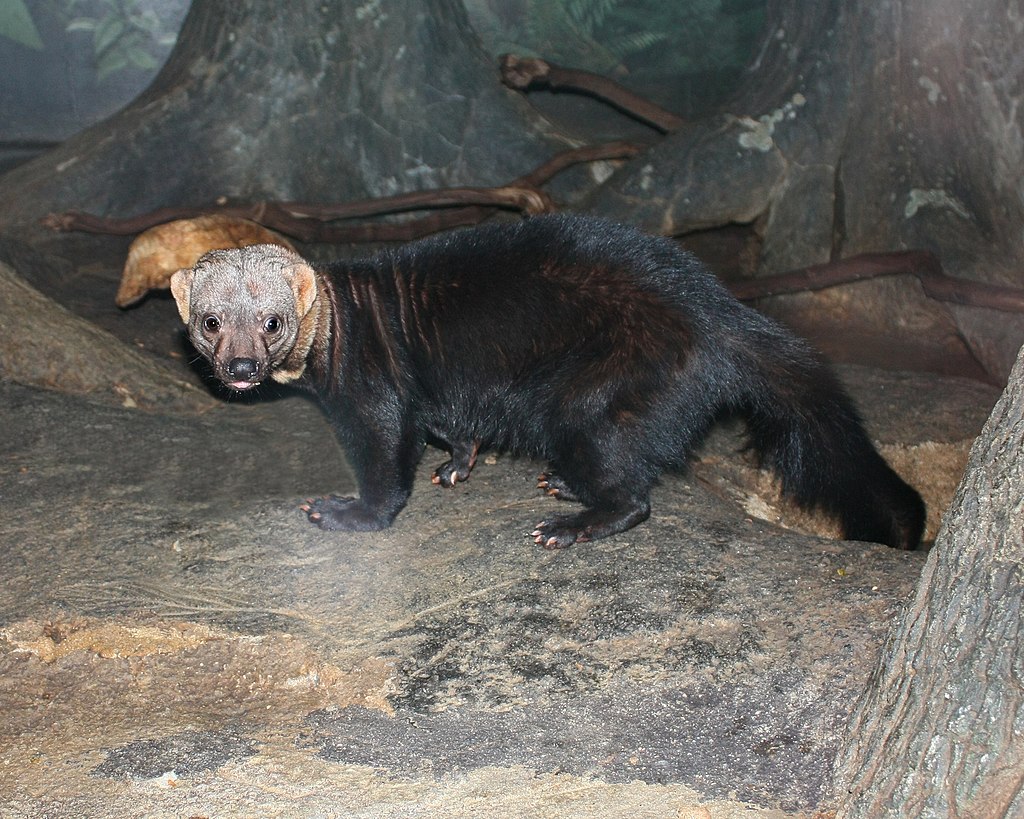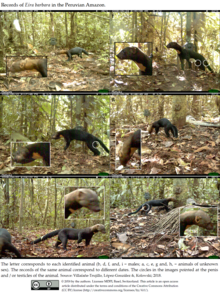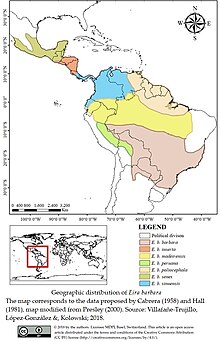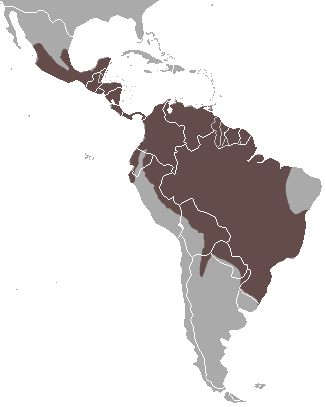Tayras are also known as the tolomuco or perico ligero in Central America, motete in Honduras, irara in Brazil, san hol or viejo de monte in the Yucatan Peninsula, and high-woods dog (or historically chien bois) in Trinidad.[2] The genus name Eira is derived from the indigenous name of the animal in Bolivia and Peru, while barbara means "strange" or "foreign".[3]

Description
Tayras are long, slender animals with an appearance similar to weasels and martens. They range from 56 to 71 cm (22 to 28 in) in length, not including a 37- to 46-cm-long (15 to 18 in) bushy tail, and weigh 2.7 to 7.0 kg (6.0 to 15.4 lb). Males are larger, and slightly more muscular, than females. They have short, dark brown to black fur which is relatively uniform across the body, limbs, and tail, except for a yellow or orange spot on the chest. The fur on the head and neck is much paler, typically tan or greyish in colour. Albino or yellowish individuals are also known, and are not as rare among tayras as they are among other mustelids.[3]
Identified individuals of E. barbara in the Peruvian Amazon
Records of E. barbara in the Peruvian Amazon 1 of 2
Records of E. barbara in the Peruvian Amazon 2 of 2
Range and habitat
Distribution of Tayra.
Subspecies
At least seven subspecies are currently recognised:[3]- E. b. barbara (northern Argentina, Paraguay, western Bolivia and central and southern Brazil)
- E. b. inserta (South Guatemala to central Costa Rica)
- E. b. madeirensis (west Ecuador and northern Brazil)
- E. b. peruana (the eastern Andes in Peru and Bolivia)
- E. b. poliocephala (eastern Venezuela, the Guianas, and northeastern Brazil)
- E. b. senex (central Mexico to northern Honduras)
- E. b. sinuensis (Colombia, western Venezuela, northern Ecuador, and Panama)
Behaviour and diet
Tayras are solitary diurnal animals, although occasionally active during the evening or at night.[5] They are opportunistic omnivores, hunting rodents and other small mammals, as well as birds, lizards, and invertebrates, and climbing trees to get fruit and honey.[3][6] They locate prey primarily by scent, having relatively poor eyesight, and actively chase it once located, rather than stalking or using ambush tactics.[5]They are expert climbers, using their long tails for balance. On the ground or on large horizontal tree limbs, they use a bounding gallop when moving at high speeds.[7] They can also leap from treetop to treetop when pursued.[citation needed] They generally avoid water, but are capable of swimming across rivers when necessary.[3]
They live in hollow trees, or burrows in the ground. Individual animals maintain relatively large home ranges, with areas up to 24 km2 (9.3 sq mi) having been recorded. They may travel at least 6 km (3.7 mi) in a single night.[3]
An interesting instance of caching has been observed among tayras: a tayra will pick unripe green plantains, which are inedible, and leave them to ripen in a cache, coming back a few days later to consume the softened pulp.[8]
Reproduction
Tayras breed year-round, with the females entering estrus several times each year for 3 to 20 days at a time.[9] Unlike some other mustelids, tayras do not exhibit embryonic diapause, and gestation lasts from 63 to 67 days. The female gives birth to one to three young, which she cares for alone.[3][10]The young are altricial, being born blind and with closed ears, but are already covered in a full coat of black fur; they weigh about 100 g (3.5 oz) at birth. Their eyes open at 35 to 47 days, and they leave the den shortly thereafter. They begin to take solid food around 70 days of age, and are fully weaned by 100 days. Hunting behaviour begins as early as three months, and the mother initially brings her young wounded or slow prey to practice on as they improve their killing technique. The young are fully grown around 6 months old, and leave their mother to establish their own territory by 10 months.[3]
A tayra from above







No comments:
Post a Comment
Note: Only a member of this blog may post a comment.